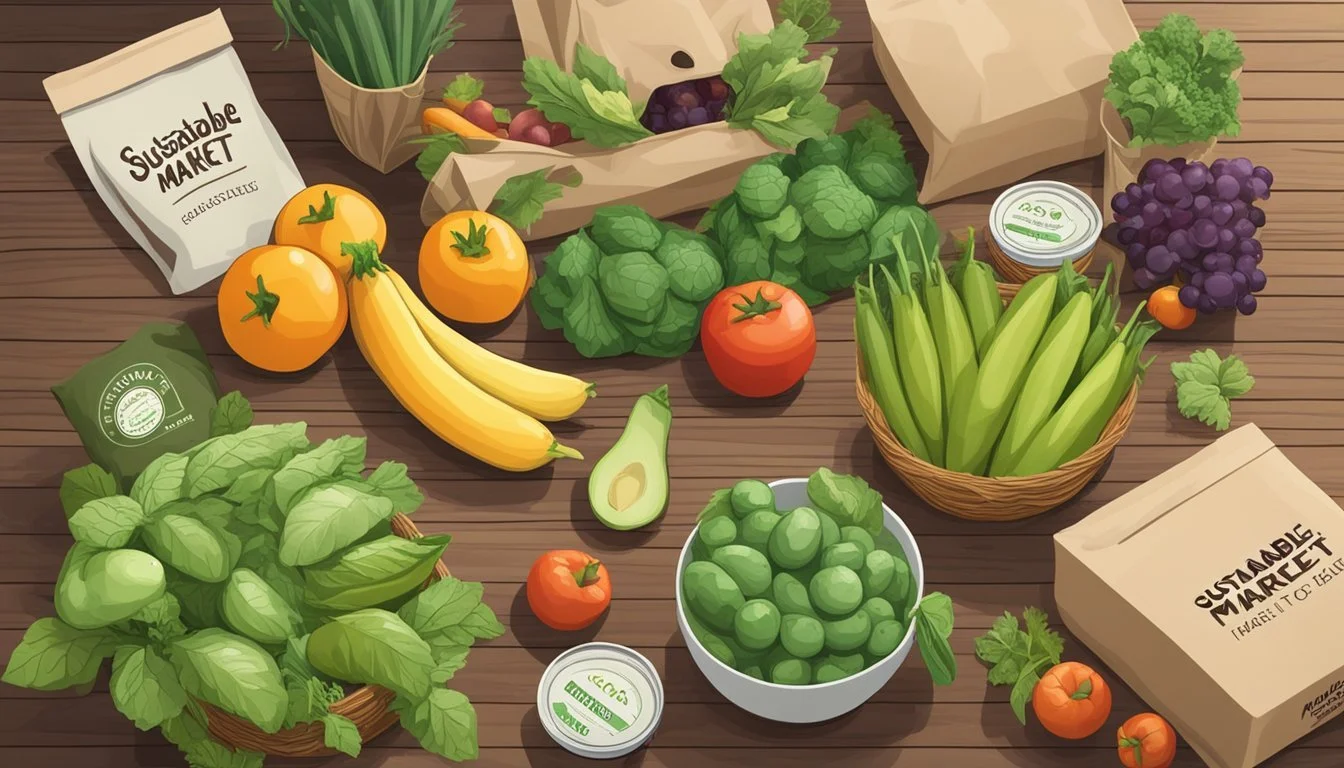Farmers' Market to Table
Optimize Your Weekly Meal Plan with Fresh Produce
Farmers' markets serve as treasure troves of local, fresh produce that can inspire and elevate home cooking. They are celebrated for providing seasonal products straight from the source, making them a focal point for those looking to embrace a farm-to-table lifestyle. Incorporating these ingredients into weekly meal planning not only supports local agriculture but also leads to meals rich in flavor and nutrition.
As shoppers stroll through the vibrant aisles of a farmers' market, they encounter a variety of fruits, vegetables, herbs, and other local products that can form the cornerstone of their weekly meal plans. By selecting the freshest items available, they set the stage for a week of wholesome, flavorful eating that also captures the essence of their region's current harvest.
Shifting the meal planning process to align with the offerings of the local market requires some strategy, but it fosters creativity and adaptability in the kitchen. It encourages cooks to think seasonally when crafting their menus, making the most of what is abundant and at its peak, and resulting in dishes that are as nutritious as they are delicious. This approach not only enriches the dining experience but also bolsters the local food economy, strengthening the bond between grower and consumer.
Understanding Farmers' Markets
Farmers' markets are cultivators of local food systems, bringing seasonal produce directly from farms to consumers. These markets support farmers and offer fresh, seasonal options for shoppers.
Benefits of Shopping Local
Support for Local Farmers: By shopping at local farmers markets, consumers directly support local farmers and their livelihoods. Money spent here stimulates the local economy, helping to sustain the agricultural community.
Environmental Impact: Choosing local produce reduces the need for long-haul transportation, lessening carbon footprints.
Freshness and Flavor: Produce at farmers' markets is often harvested at peak ripeness, which translates to superior flavor and freshness compared to items shipped over long distances.
Seasonality and Local Produce
Seasonal Produce: Farmers' markets specialize in offering what is currently in season in the local region. Seasonal produce tends to be fresher, tastier, and better for the environment due to reduced transportation needs.
Season Examples of Local Produce Spring Asparagus, strawberries Summer Tomatoes, peaches Autumn Apples, pumpkins Winter Squashes, kale
Education: Consumers have the opportunity to learn about what is in season and how to incorporate seasonal produce into their meal planning, fostering a deeper connection with the local food system.
Essentials of Meal Planning
In meal planning, success hinges on a well-stocked pantry, a diverse weekly menu, and a structured plan. These elements allow for an efficient and stress-free approach to transforming market-fresh produce into nutritious meals.
Creating a Versatile Pantry
A pantry equipped with a variety of non-perishable staples is the foundation of successful meal planning. This versatility ensures that one has the essentials for a wide range of recipes at any given time. Key pantry items include grains, such as quinoa and rice, and flavor-boosting condiments like mustard and balsamic vinaigrette. Here's a basic list to keep one's pantry ready for action:
Grains: rice, quinoa, pasta
Oils: olive oil, vegetable oil
Condiments: mustard, sriracha sauce, soy sauce, vinegar
Canned goods: beans, tomatoes, coconut milk
Crafting a Balanced Meal Plan
They should aim for balance when crafting a meal plan, including a variety of nutrients and flavors. This involves categorizing the week's meals into proteins, vegetables, and carbohydrates while being mindful of personal dietary needs. One's grocery list reflects this diverse approach, ensuring fresh fruits and vegetables are prominent and complemented by meats, dairy, or plant-based proteins. Here's a concise template for a balanced weekly meal plan:
Protein: Choose lean meats, fish, eggs, or plant-based alternatives.
Vegetables: Incorporate a mixture of leafy greens and colorful veggies.
Carbohydrates: Select whole grains or starchy vegetables.
Fruits: Opt for seasonal fruits for desserts or snacks.
Weekly Meal Planning Template
A weekly meal-planning template is a visual and organizational aid that helps one stay on track with their meal plan. It incorporates routine with flexibility to adjust for unforeseen changes. A calendar-style template allows one to assign meals to specific days, ensuring that they effectively use ingredients before they expire. The template suggests preparing versatile bases earlier in the week to enable quick assembly of meals later on. Below is an example formula for structuring a weekly meal plan:
Day Breakfast Lunch (What wine goes well with lunch?) Dinner Monday Baked Oatmeal with Blueberries Quinoa Salad Grilled Chicken with Veggies Tuesday Greek Yogurt with Honey Leftover Chicken Wrap Veggie Stir-fry with Rice ... ... ... ...
By maintaining an organized pantry, crafting a balanced meal plan, and utilizing a weekly meal-planning template, individuals can streamline the process from the farmers' market to their table.
Assembling Your Shopping List
Crafting the ideal shopping list for weekly meals begins with understanding seasonal availability, including a variety of fresh produce, and focusing on nutritious food choices to create a balanced diet.
Deciphering the Seasonal Calendar
The savvy shopper knows that seasonally available fruits and vegetables not only taste better but are often more affordable. One can save money and enjoy peak flavor by purchasing what's in season. A seasonal calendar can help in identifying such produce and should be the first reference when assembling a shopping list.
Spring: Asparagus, strawberries, and peas
Summer: Tomatoes, corn, and berries
Fall: Apples, squash, and root vegetables
Winter: Citrus fruits, kale, and pomegranates
Incorporating Fresh Produce
Once one understands what is in season, the next step is to incorporate a variety of these items into the shopping list. Fresh produce should form the core of meal planning, with a focus on creating a colorful and nutrient-rich plate. They should ask questions at the farmers' market to learn more about how to select and prepare these items:
How do I pick the best avocados for ripeness this week?
What's the best way to store fresh herbs?
Prioritizing Nutritious Choices
Prioritize items on the shopping list that offer a high nutritional value. Vegetables and fruits are packed with essential vitamins, minerals, and fiber. When planning meals, consider creating a balance by pairing fresh produce with lean proteins, whole grains, and healthy fats.
For instance, one might pair:
Leafy greens with quinoa and grilled chicken for a balanced meal.
Sweet potatoes with black beans and avocado for a nutrient-dense vegetarian option.
Breakfast Ideas
Farmers' markets provide a wealth of fresh ingredients that can invigorate morning routines with nutritious and flavorful breakfast options. By focusing on simple preparations and nutrient-dense foods, individuals can create breakfasts that are both energizing and satisfying.
Energizing Starters
For a quick and vibrant start, fruit stands out as a perfect choice. Farmers' market enthusiasts can enjoy a variety of in-season fruits such as berries, apples, or peaches. Combining these fruits with a small handful of nuts or a dollop of yogurt can offer a satisfactory protein boost.
Eggs are another excellent source of morning protein and can be prepared in numerous ways. Scrambled eggs with fresh spinach, roasted tomatoes, or sautéed mushrooms incorporate the freshness of market produce while delivering a balanced and protein-rich breakfast.
Wholesome Grains and Proteins
Oats serve as a versatile grain base for many breakfast options. Overnight oats soaked in almond milk topped with fresh market fruits, chia seeds, and a swirl of local honey can provide a heart-healthy and fiber-filled meal. For a warm option, steel-cut oats with diced apple and cinnamon make for a comforting and nutritious start to the day.
Those seeking vegetarian protein sources can turn to tofu scrambles. Marrying tofu with a colorful array of peppers, onions, and leafy greens replicates the feel of scrambled eggs and offers a plant-based protein kick. Adding a sprinkle of nutritional yeast can impart a cheese-like flavor and added nutrients.
Farmers' markets inspire a return to basics with fresh, seasonal produce and whole foods that elevate the first meal of the day. By selecting high-quality ingredients and pairing them thoughtfully, breakfasts can become a highlight of one's daily meal prep routine.
Lunch Inspirations
For those looking to make the most of their farmers' market finds, lunch presents an excellent opportunity to be creative with fresh ingredients. This section focuses on how to construct nutritious and satisfying midday meals, with a special emphasis on salads, wraps, and more substantial options to keep energy levels high throughout the day.
Fresh Salads and Wraps
Farmers' markets offer an array of fresh greens, including lettuce, spinach, and arugula, that can form the base of diverse salads and wraps. Start with a mix of these greens and add colorful toppings like tomatoes, radishes, and carrots. For added protein, consider incorporating grilled chicken or chickpeas. Here's a simple table on how to combine these ingredients for a balanced lunch:
Base Green Protein Option Additional Veggies Dressing Lettuce Grilled chicken Sliced tomatoes Vinaigrette Spinach Chickpeas Diced radish Lemon juice Arugula Tuna Shredded carrots Greek yogurt
Wrap Tip: For kids' lunches or a portable option, transfer these salad components into a whole grain tortilla. Spread some hummus for additional flavor and to help the wrap hold together.
Hearty Midday Meals
Hearty meals for lunch help maintain energy levels for the rest of the day. Utilize root vegetables such as sweet potatoes or beets, roasting them with herbs to enhance their natural sweetness. Pair with a portion of protein like turkey or beef slices from the market. For those who prefer vegetarian options, a quinoa or farro grain bowl with roasted vegetables (What wine goes well with roasted vegetables?) and a drizzle of olive oil dressing can be both satisfying and nutritious.
Meal Prep Tip: Preparing components such as roasted vegetables and grains in advance saves time and encourages the inclusion of diverse nutrients in daily meals. These ingredients can be easily assembled in different combinations throughout the week for a variety of flavorful lunch options.
Dinner Solutions
In crafting dinner solutions from the farmers' market to the table, the focus is on utilizing fresh, seasonal produce and quality proteins to create main courses that delight, paired with savory side dishes that complement and enhance.
Main Courses
Farmers' markets offer an abundance of fresh proteins perfect for the main dish. For example, one could select pasture-raised chicken for a robust Chicken Sweet Potato Curry, where the meat's natural flavors are accentuated by the sweetness of in-season sweet potatoes. Similarly, burgers made from grass-fed beef provide a hearty, flavorful dinner option. They can be topped with heirloom tomatoes and homemade pickles from market ingredients.
Savory Side Dishes
The perfect accompaniment to any main dish comes in the form of savory side dishes. Consider small, roasted potatoes seasoned with garlic and rosemary for a simple yet satisfying option. One can also prepare a corn salad, pairing kernels from freshly-picked ears with diced bell peppers (What wine goes well with bell peppers?) and a light vinaigrette. Each side dish should serve as a celebration of the season’s bounty, making the most of what is locally available.
Smart Cooking Techniques
In preparing meals with farmers' market finds, one optimizes flavors and streamlines cooking processes to create dishes that are both delicious and efficient to make.
Utilizing Seasonal Flavors
Seasonal ingredients are the stars of farmers' market cuisine. One can maximize their potential by marinating or seasoning them appropriately. For instance, heirloom tomatoes can be transformed with a simple marinade of minced garlic, olive oil, and balsamic vinegar. Let the mixture sit for an hour before serving to allow the flavors to meld.
Seasonal Vegetable Suggested Preparation Tomatoes Marinate in garlic, olive oil, and balsamic vinegar Zucchini Grill with a brush of olive oil and a sprinkle of herbs Corn Boil briefly and serve with a knob of butter
Seasonal dishes boast both heightened flavor and nutritional value. Incorporating herbs like basil can complement and elevate the innate taste of fresh produce.
Efficient Cooking Methods
They implement efficient cooking methods to cut down on meal prep time without sacrificing food quality. Techniques such as batch frying or grilling vegetables not only save time but also add layers of texture and taste. For example, vegetables like bell peppers and eggplants (What wine goes well with eggplant?) can be grilled in larger quantities and used throughout the week in various recipes such as salads, pastas, or as a side dish.
Grilling Chart
Vegetable Prep Grill Time Tips Bell Peppers Slice into squares 5-8 min per side Grill skin-side down first Eggplants Slice into rounds 4-6 min per side Salt slices to remove excess water
When they are making a farmers market breakfast bread, incorporating shredded vegetables into the batter before baking adds nutrition and keeps the dish moist. Utilizing the oven allows for a 'set-and-forget' approach, letting one concentrate on preparing other parts of the meal while it cooks.
By being mindful of the methods used, they ensure ingredients are the focal point of each dish, and that cooking remains an enjoyable, stress-free experience.
Incorporating Diversity in Meals
Integrating a vibrant variety of foods into weekly meal prep is essential for ensuring well-rounded nutrition and culinary excitement. Embracing both global cuisine and a multiplicity of fresh produce can enrich one's diet significantly.
Exploring Global Cuisine
One's culinary repertoire can be expanded by exploring global cuisine, implementing foods like Salmorejo (a Spanish cold tomato soup), Chana Masala (a North Indian chickpea dish), or Miso Soup (a traditional Japanese soup). These dishes not only introduce a rich tapestry of flavors but also open avenues to understand diverse cultures through their unique ingredients and cooking methods. Often, these recipes include healthful, plant-based components that align with Mediterranean-style diets, known for their health benefits and emphasis on vegetables, legumes, and grains.
Trying New Vegetables and Herbs
Diversifying one's vegetable intake can be as simple as incorporating less familiar varieties into weekly meal prep. Rainbow chard, with its nutrient-packed colorful stalks, may add visual appeal and a slight peppery taste to dishes. Other vegetables like arugula, known for its spicy kick, or fresh herbs such as basil and parsley, can uplift a meal's flavor profile dramatically. These greens can be added to salads, sandwiches, or as garnishes to finished dishes to enhance color, texture, and nutritional value.
Vegetables & Herbs Description Possible Uses Rainbow Chard Brightly colored and nutrient-dense, offering earthy flavors Sautéed as a side dish, incorporated in quiches Arugula Peppery green, rich in antioxidants Salads, pizza topping, blended into pesto Fresh Basil Sweet aromatic herb, staple in Mediterranean cuisine Tomato-based dishes, infused oils, dressings Parsley Clean, slightly bitter herb Garnishes, incorporated in sauces, marinades
In embracing such diversity in vegetables and herbs, meal preppers not only bolster their nutrient intake but also keep their taste buds keenly engaged.
Saving Time with Meal Prep
Incorporating a structured meal prep routine can significantly streamline the weekly meal process, offering time-saving benefits and cost-effectiveness. Families, including those with kids, may find that meal preparation not only simplifies their schedules but also reduces food waste.
Advance Preparation Strategies
Batch Cooking: One can make use of a practice known as "planned overs", which involves cooking more food than necessary during a meal to ensure leftovers. For instance, making double the amount of taco toppings for dinner allows them to be repurposed into taco salads for the following day's lunch.
Wash and Cut Vegetables: After a visit to the farmers' market, washing and cutting vegetables like celery, cherry tomatoes, cucumbers, and radishes upfront can save precious time during the week. Store them properly to maintain freshness:
Celery: Store washed and cut into sticks for up to 4 days.
Cherry Tomatoes: Keep for up to 5 days, washed and dried well.
Cucumbers: Last up to 5 days, washed, peeled (optional), and sliced.
Radishes: Stay fresh for up to 4 days, washed and sliced into rounds.
Making Meals Ahead
Breakfast Preps: A Farmers Market Breakfast Bread can be made in advance by heating the oven to 350°F, preparing a loaf pan, and mixing the batter with fresh market vegetables. Once baked until golden-brown, this breakfast option can serve as a quick meal for several mornings.
One-Pan Cooking: To save time, cook multiple ingredients simultaneously on one pan. Durable vegetables like potatoes and parsnips can withstand longer cooking times and are ideal for bulk cooking. This method ensures meals are prepared efficiently and can last throughout the week.
By deploying these meal prep methods, one can achieve a balance between fresh, homemade meals and a more manageable weekly routine.
Sustainable Eating and Living
Adopting sustainable eating and living practices involves incorporating locally sourced and homegrown foods into one's diet. This approach not only supports the local ecosystem but also promotes a healthier lifestyle by utilizing fresh, seasonal produce.
Growing Your Own Produce
Individuals who grow their own garden contribute to a sustainable lifestyle by providing themselves with fresh, chemical-free produce. A garden can be abundant with seasonal vegetables such as heirloom tomatoes in summer and squash in the fall. By selecting a variety of crops, growers can harvest a steady supply of produce throughout the growing seasons.
Spring: lettuce, spinach, and peas
Summer: tomatoes, cucumbers, and peaches
Fall: squash, carrots, and kale
Supporting the Local Ecosystem
Shopping at one's local farmers market is a direct way to support the local economy and encourage sustainable practices. Purchasing from local producers means less transportation, freshness, and nutrient retention of the food consumed. Meals made with farmers market finds often feature a rich array of flavors from the peak readiness of the produce, such as bright, juicy peaches and crisp, flavorful green bell peppers.
Examples of farmers market meals:
Grilled squash topped with fresh herbs
Salad with mixed greens and heirloom tomatoes
Stir-fry featuring seasonal vegetables and local meats
Engaging with Your Community
Engagement with the community cultivates a deeper connection between consumers and their local food systems. This engagement not only enriches the culinary experience but also fortifies the economic and social bonds within the locality.
Learning from Local Vendors
Local vendors at farmer's markets are a treasure trove of knowledge and experience. Visitors can learn about the origins of the produce, the best ways to prepare them, and individual stories that each vendor carries. This interaction is a learning opportunity, as vendors often share preparation tips and recipes directly related to their products. It's more than a transaction; it's an exchange of wisdom and passion for food.
Ask Questions: Inquire about the produce—where it's from, how it's grown, or any unique cooking suggestions they might have.
Recipe Exchange: Vendors may offer recipe cards or cooking demonstrations, embracing the seasonal availability of their goods.
Farming Practices: For those interested in sustainable agriculture, vendors can offer insights into their farming techniques and the benefits of supporting local produce.
Participating in Local Food Events
Farmer's markets often serve as hubs for local food events, providing a platform for community involvement and celebration of local cuisine. These events can include cooking competitions, taste tests, and educational workshops, which encourage people to connect over shared interests in food sustainability and community health.
Event Calendar: Most markets have a schedule of events. It's beneficial to stay informed about upcoming gatherings.
Workshops: Look out for cooking workshops or demonstrations that focus on seasonal produce available at the market.
Community Building: Events often serve as networking opportunities, where attendees can meet like-minded individuals committed to supporting local agriculture.
Attending these events not only supports local vendors and farmers but also strengthens the community bond. Consumers engaging in these activities become part of a cycle that values local produce and the hard work of their neighbors, culminating in a more robust local food system.
Frequently Asked Questions
This section addresses various questions one may have about integrating farmers market visits into weekly meal planning and shopping routines.
Common Inquiries About Meal Planning
Q: How does one effectively plan meals around a farmers market trip?
A: Individuals should first check what produce is in season and then create a meal planning grid for the week. This allows one to tailor the shopping list to what's available, ensuring fresh, seasonal ingredients.
Q: What approach helps with meal planning on a budget?
A: To plan meals on a budget, start by making a list of ingredients needed for the week's meals, focusing on seasonal produce which is often less expensive. Being flexible with the meal plan, depending on what products are on offer, can also reduce costs.
Shopping and Produce Queries
Q: What should one look for when shopping for produce at the farmers market?
A: Shoppers should look for fresh, in-season produce. Building relationships with the farmers can provide insights into the best picks and might lead to future discounts.
Q: How does one maintain freshness when buying from a farmers market?
A: Buying only what's needed for the week and proper storage are key. For example, leafy greens should be stored in the refrigerator, while root vegetables can last in a cool, dry place.
By addressing these specific inquiries, individuals can shop at farmers markets confidently, integrate seasonal produce into their meal plans, and maintain their budget.











